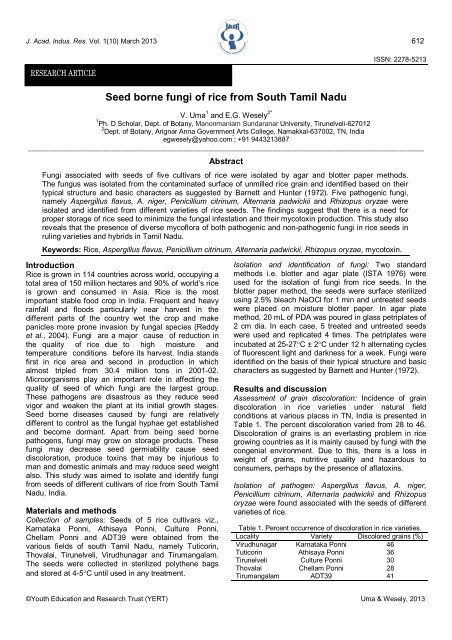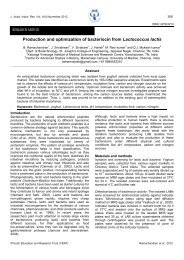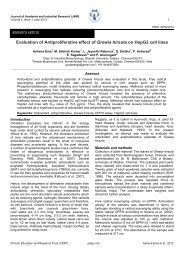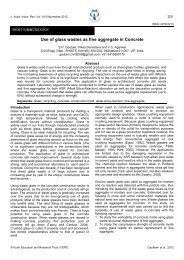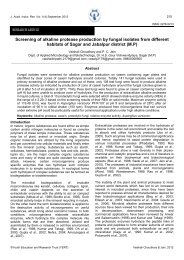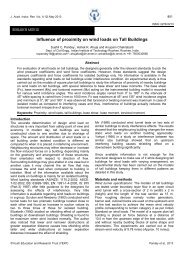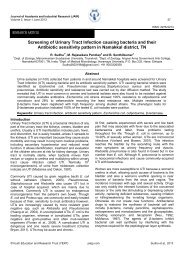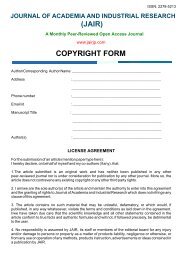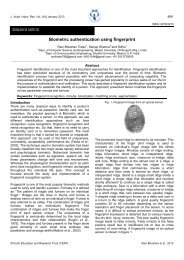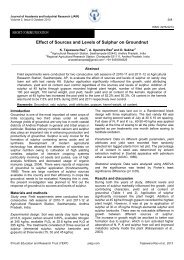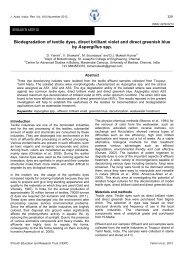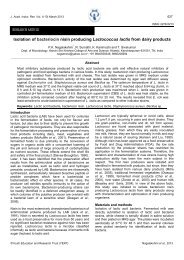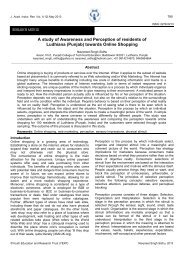Seed borne fungi of rice from South Tamil Nadu
Seed borne fungi of rice from South Tamil Nadu
Seed borne fungi of rice from South Tamil Nadu
You also want an ePaper? Increase the reach of your titles
YUMPU automatically turns print PDFs into web optimized ePapers that Google loves.
J. Acad. Indus. Res. Vol. 1(10) March 2013 612RESEARCH ARTICLEISSN: 2278-5213<strong>Seed</strong> <strong>borne</strong> <strong>fungi</strong> <strong>of</strong> <strong>rice</strong> <strong>from</strong> <strong>South</strong> <strong>Tamil</strong> <strong>Nadu</strong>V. Uma 1 and E.G. Wesely 2*1 Ph. D Scholar, Dept. <strong>of</strong> Botany, Manonmaniam Sundaranar University, Tirunelveli-6270122 Dept. <strong>of</strong> Botany, Arignar Anna Government Arts College, Namakkal-637002, TN, Indiaegwesely@yahoo.com * ; +91 9443213887______________________________________________________________________________________________AbstractFungi associated with seeds <strong>of</strong> five cultivars <strong>of</strong> <strong>rice</strong> were isolated by agar and blotter paper methods.The fungus was isolated <strong>from</strong> the contaminated surface <strong>of</strong> unmilled <strong>rice</strong> grain and identified based on theirtypical structure and basic characters as suggested by Barnett and Hunter (1972). Five pathogenic <strong>fungi</strong>,namely Aspergillus flavus, A. niger, Penicillium citrinum, Alternaria padwickii and Rhizopus oryzae wereisolated and identified <strong>from</strong> different varieties <strong>of</strong> <strong>rice</strong> seeds. The findings suggest that there is a need forproper storage <strong>of</strong> <strong>rice</strong> seed to minimize the fungal infestation and their mycotoxin production. This study alsoreveals that the presence <strong>of</strong> diverse myc<strong>of</strong>lora <strong>of</strong> both pathogenic and non-pathogenic <strong>fungi</strong> in <strong>rice</strong> seeds inruling varieties and hybrids in <strong>Tamil</strong> <strong>Nadu</strong>.Keywords: Rice, Aspergillus flavus, Penicillium citrinum, Alternaria padwickii, Rhizopus oryzae, mycotoxin.IntroductionRice is grown in 114 countries across world, occupying atotal area <strong>of</strong> 150 million hectares and 90% <strong>of</strong> world’s <strong>rice</strong>is grown and consumed in Asia. Rice is the mostimportant stable food crop in India. Frequent and heavyrainfall and floods particularly near harvest in thedifferent parts <strong>of</strong> the country wet the crop and makepanicles more prone invasion by fungal species (Reddyet al., 2004). Fungi are a major cause <strong>of</strong> reduction inthe quality <strong>of</strong> <strong>rice</strong> due to high moisture andtemperature conditions before its harvest. India standsfirst in <strong>rice</strong> area and second in production in whichalmost tripled <strong>from</strong> 30.4 million tons in 2001-02.Microorganisms play an important role in affecting thequality <strong>of</strong> seed <strong>of</strong> which <strong>fungi</strong> are the largest group.These pathogens are disastrous as they reduce seedvigor and weaken the plant at its initial growth stages.<strong>Seed</strong> <strong>borne</strong> diseases caused by <strong>fungi</strong> are relativelydifferent to control as the fungal hyphae get establishedand become dormant. Apart <strong>from</strong> being seed <strong>borne</strong>pathogens, <strong>fungi</strong> may grow on storage products. These<strong>fungi</strong> may decrease seed germiability cause seeddiscoloration, produce toxins that may be injurious toman and domestic animals and may reduce seed weightalso. This study was aimed to isolate and identify <strong>fungi</strong><strong>from</strong> seeds <strong>of</strong> different cultivars <strong>of</strong> <strong>rice</strong> <strong>from</strong> <strong>South</strong> <strong>Tamil</strong><strong>Nadu</strong>, India.Materials and methodsCollection <strong>of</strong> samples: <strong>Seed</strong>s <strong>of</strong> 5 <strong>rice</strong> cultivars viz.,Karnataka Ponni, Athisaya Ponni, Culture Ponni,Chellam Ponni and ADT39 were obtained <strong>from</strong> thevarious fields <strong>of</strong> south <strong>Tamil</strong> <strong>Nadu</strong>, namely Tuticorin,Thovalai, Tirunelveli, Virudhunagar and Tirumangalam.The seeds were collected in sterilized polythene bagsand stored at 4-5C until used in any treatment.Isolation and identification <strong>of</strong> <strong>fungi</strong>: Two standardmethods i.e. blotter and agar plate (ISTA 1976) wereused for the isolation <strong>of</strong> <strong>fungi</strong> <strong>from</strong> <strong>rice</strong> seeds. In theblotter paper method, the seeds were surface sterilizedusing 2.5% bleach NaOCl for 1 min and untreated seedswere placed on moisture blotter paper. In agar platemethod, 20 mL <strong>of</strong> PDA was poured in glass petriplates <strong>of</strong>2 cm dia. In each case, 5 treated and untreated seedswere used and replicated 4 times. The petriplates wereincubated at 25-27C ± 2C under 12 h alternating cycles<strong>of</strong> fluorescent light and darkness for a week. Fungi wereidentified on the basis <strong>of</strong> their typical structure and basiccharacters as suggested by Barnett and Hunter (1972).Results and discussionAssessment <strong>of</strong> grain discoloration: Incidence <strong>of</strong> graindiscoloration in <strong>rice</strong> varieties under natural fieldconditions at various places in TN, India is presented inTable 1. The percent discoloration varied <strong>from</strong> 28 to 46.Discoloration <strong>of</strong> grains is an everlasting problem in <strong>rice</strong>growing countries as it is mainly caused by <strong>fungi</strong> with thecongenial environment. Due to this, there is a loss inweight <strong>of</strong> grains, nutritive quality and hazardous toconsumers, perhaps by the presence <strong>of</strong> aflatoxins.Isolation <strong>of</strong> pathogen: Aspergillus flavus, A. niger,Penicillium citrinum, Alternaria padwickii and Rhizopusoryzae were found associated with the seeds <strong>of</strong> differentvarieties <strong>of</strong> <strong>rice</strong>.Table 1. Percent occurrence <strong>of</strong> discoloration in <strong>rice</strong> varieties.Locality Variety Discolored grains (%)Virudhunagar Karnataka Ponni 46Tuticorin Athisaya Ponni 36Tirunelveli Culture Ponni 30Thovalai Chellam Ponni 28Tirumangalam ADT39 41©Youth Education and Research Trust (YERT) Uma & Wesely, 2013
J. Acad. Indus. Res. Vol. 1(10) March 2013 613Table 2. Pathogen associated with discolored <strong>rice</strong> grains.VarietyPercentage <strong>of</strong> associationA. niger A. flavus Alternaria padwickii Penicillium citrinum Rhizopus oryzaeKarnataka Ponni 16.24 18.00 17.50 6.00 2.00Athisaya Ponni 16.00 15.00 8.00 4.25 0.00Culture Ponni 15.00 13.00 14.28 8.25 7.50Chellam Ponni 12.00 12.50 8.25 4.75 1.60ADT39 17.60 9.25 11.25 5.25 2.50The frequency <strong>of</strong> fungal association and occurrence wasvaried in different varieties <strong>of</strong> <strong>rice</strong> seeds. Earlierobservations reported the occurrence <strong>of</strong> Pyriculariaoryzae, Alternaria alternata, A. padwickii,A. longissima, Curvularia oryzae, C. lunata, Drechsleraoryzae, A. niger, Fusarium moniliforme, F. semitectum,F. oxysporum, F. solani and species <strong>of</strong> Phoma,Cercospora, Chaetomium, Sclerotium, Penicillium,Myrothecium and Colletotrichum <strong>from</strong> seeds <strong>of</strong> differentvarieties <strong>of</strong> <strong>rice</strong> (Khan, 2000; Wahid et al., 2001; Javaidet al., 2002; Nguefack et al., 2007). In this study, it wasobserved that Aspergillus niger, A. flavus, Penicilliumcitrinum, Alternaria padwickii and Rhizopus oryzaepresence in the seeds <strong>of</strong> different <strong>rice</strong> varieties.In Karnataka Ponni, highest percentage (18%) <strong>of</strong>A. flavus association was observed. Aspergillus nigershowed 17.6% <strong>of</strong> occurrence in ADT39 followed by17.5% in Karnataka ponni.The fungal association with the selected <strong>rice</strong> varieties isdepicted in Table 2. Suleiman and Taiga (2009) reportedfungal pathogen as the major cause <strong>of</strong> reduction in thequality <strong>of</strong> stored <strong>rice</strong> when insects and rodents arecontrolled. Rice growing in the field is contaminated withnumerous <strong>fungi</strong> which include <strong>rice</strong> blast caused byMagnaporthe grisea, <strong>rice</strong> sheath blight caused byRhizoctonia solani, brown spot caused by Cochlioblusmiyabeanus and false smut caused Ushlaginoidia virens(Nguefack et al., 2007). Stored <strong>rice</strong> grains are prone t<strong>of</strong>ungal attack, especially at a moderate temperature andhigh humidity. Spoilage <strong>of</strong> stored <strong>rice</strong> is attributed tostorage <strong>fungi</strong> which were introduced during thepost-harvest handling process (Javaid et al., 2002).In this study, Aspergillus niger was isolated <strong>from</strong>3 samples collected <strong>from</strong> 3 major markets <strong>of</strong> the studyareas. This confirms that the fungus is widely associatedwith unmilled <strong>rice</strong> grain and in storage which may resultin deterioration in form <strong>of</strong> discoloration and bad odorsmay occur with reduction in milling yield due to partlygrowth <strong>of</strong> mould and other microorganisms. The isolatedfungus was associated with stored <strong>rice</strong> with varyingfrequencies in the 5 localities sampled (Table 2).Presence <strong>of</strong> Aspergillus spp., especially A. niger andA. flavus on seeds <strong>of</strong> <strong>rice</strong> in higher frequencies and itsassociation with ungerminated seeds <strong>of</strong> <strong>rice</strong> confirmedthat species <strong>of</strong> Aspergillus though occur as saprophytesmay cause low germination in seeds. A number <strong>of</strong> <strong>fungi</strong>isolated in this study are known to produce mycotoxinswhich are harmful for human health.Mycotoxins can cause severe damage to liver, kidneyand nervous system <strong>of</strong> man even in low dosages(Rodricks, 1976). Aspergillus spp. are common fungalcontaminants <strong>of</strong> cereals and also produces mycotoxins(Bakan et al., 2002; Toth and Teren, 2005). Aspergillusflavus produces aflatoxins which were carcinogenic andproduce liver cancer (Purchase, 1974; Diener and Davis,1969; Pesta and Bonday, 1990). So, <strong>from</strong> the study, it isnoted that there is a need for proper storage <strong>of</strong> <strong>rice</strong> seedto minimize the fungal infestation and mycotoxinproduction during storage and provide disease freeseeds for human consumption. This study also revealsthe presence <strong>of</strong> diverse myc<strong>of</strong>lora <strong>of</strong> both pathogenicand non-pathogenic <strong>fungi</strong> in <strong>rice</strong> seeds in ruling varietiesand hybrids in <strong>Tamil</strong> <strong>Nadu</strong>.ConclusionFive pathogenic <strong>fungi</strong>, namely Aspergillus flavus,A. niger, Penicillium citrinum, Alternaria padwickii andRhizopus oryzae were isolated <strong>from</strong> different varieties <strong>of</strong><strong>rice</strong> seeds. The study revealed the presence <strong>of</strong> diversemyc<strong>of</strong>lora <strong>of</strong> both pathogenic and non-pathogenic <strong>fungi</strong> in<strong>rice</strong> seeds in ruling varieties and hybrids in <strong>Tamil</strong> <strong>Nadu</strong>.To conclude, the findings suggest that there is a need forproper storage <strong>of</strong> <strong>rice</strong> seed to minimize the fungalinfestation and their mycotoxin production in near future.References1. Bakan, B., Richard, D., Molard, D. and Cahagnier, B. 2002.Fungal growth and Fusarium mycotoxin content in isogenictraditional maize and genetically modified maize grown inFrance and Spain. J. Agri. Food Chem. 50(4): 278-731.2. Barnett, H.L. and Hunter, S.B. 1972. Illustrated genera <strong>of</strong>imperfect <strong>fungi</strong>. Minnesota. Burgess Publications. p.241.3. Diener, U.L. and Davis, N.D. 1969. Relation <strong>of</strong> environmentto aflatoxin production <strong>from</strong> Aspergillus flavus. In: Aflatoxin.(Ed.): L.A Goldblatt Academic Press. New York. pp.15-34.4. ISTA (International <strong>Seed</strong> Testing Association). 1993.International rules for seed testing. Rules amendments.<strong>Seed</strong> Sci. Technol. 29: 1-127.5. Javaid, M.S., Wahid, A. Idrees, M., Gill, M.A. and Saleem,A. 2002. <strong>Seed</strong> myc<strong>of</strong>lora studies in <strong>rice</strong>. Pak. J.Phytopathol. 14: 132-134.6. Khan, T.Z., Gill, M.A. and Khan, M.G. 2000. <strong>Seed</strong> <strong>borne</strong><strong>fungi</strong> <strong>of</strong> <strong>rice</strong> <strong>from</strong> central Punjab and their control. Pak. J.Phytopathol. 12: 12-14.7. Nguefack, J., Nguikwie, S.K. and Fotio, D. 2007. Fungicidalpotential <strong>of</strong> essential oils and fractions <strong>from</strong>Cymbopogon citratus, Ocimum gratissimmum andThymus vulgaris to control Alternaria padwickii andBipolaris oryzae, two seed-<strong>borne</strong> <strong>fungi</strong> <strong>of</strong> <strong>rice</strong> (Oryzasativa L.). J. Essential Oil Res. 17: 581-587.©Youth Education and Research Trust (YERT) Uma & Wesely, 2013
J. Acad. Indus. Res. Vol. 1(10) March 2013 6148. Pesta, J.J. and Bonday, G.S. 1990. Alternation <strong>of</strong> immunefunction following dietry mycotoxin exposure. Can. J.Physiol. Pharmacol. 68: 1009-1016.9. Purchase, I.R.H. 1974. Mycotoxin. Elsevier Scientific Publ.com. Amsterdam. p.443.10. Reddy, C.S., Reddy, K.R.N., Kumar, R.N., Laha, G.S. andMuralidharan, K. 2004. Exploration <strong>of</strong> aflatoxincontamination and its management in <strong>rice</strong>. J. Mycol. Pl.Pathol. 34(3): 816-820.11. Rodricks, J.V. 1976. Mycotoxins and other fungus relatedfood problems. Advance in chemistry, Series 149. AmericanChemicals Society, Washington, p.239.12. Suleiman, M.N. and Taiga, A. 2009. Efficacy <strong>of</strong> aqueousextracts <strong>of</strong> neem and sharf <strong>from</strong> the control <strong>of</strong> <strong>fungi</strong>associated with milled and unmilled stored <strong>rice</strong> grain. Proc.<strong>of</strong> 5 th AKURE-HUMBOLDT ELLOG/SAAT Annual Conf.pp.71-73.13. Toth, V.B. and Teren, J. 2005. Mycotoxin producing <strong>fungi</strong>and mycotoxins in foods in Hungary. J. ActaAlimentaria/Akademiai. pp.267-275.14. Wahid, A., Javaid, M.S., Idrees, M. and Gill, M.A. 2001.Studies on the association and effect <strong>of</strong> Fusarium solanion <strong>rice</strong> seeds in Punjab, Pakistan. In: Proc. 3 rd NationalConf. Plant Pathology, Oct. 1-3, 2001. NARC Islamabad.pp.70-72.©Youth Education and Research Trust (YERT) Uma & Wesely, 2013


